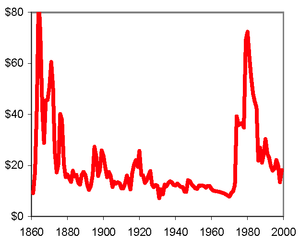1979 energy crisis
|
|

The 1979 (or second) energy crisis occurred in the wake of the Iranian Revolution. In the wake of protests, the Shah of Iran fled his country in early 1979 allowing Ayatollah Khomeini to gain control. The protests shattered the Iranian oil sector. While the new regime resumed oil exports, it was inconsistent and at a lower volume, driving up prices. In the United States, oil lines reappeared as they had six years earlier.
During the period, many people believed the oil shortages were artificially created by the oil companies to drive up prices, rather than created by outside factors. Further, while in a market economy, shortages would be expected to drive up prices, causing a contraction in demand, of themselves they would be unlikely to result in queues at the gas pump but for artificial regulations and price controls. Many politicians proposed gas rationing, such as the Governor of Maryland, who proposed odd-even rationing (only people with an odd-numbered license plate could purchase gas on an odd-numbered day). This did not last long.
President Jimmy Carter made symbolic efforts to encourage energy conservation, such as wearing a sweater, and installing solar power panels on the roof of the White House and a wood stove in the living quarters. However, Ronald Reagan ordered the solar panels removed and the wood stove was dismantled. Carter made a speech arguing the oil crisis was "the moral equivalent of war". More importantly, Carter, as part of his administration's efforts at deregulation, proposed removing price controls that had been imposed in the administration of Richard Nixon during the 1973 energy crisis. Congress agreed to remove price controls in phases; they were finally dismantled in 1981 under Ronald Reagan
In 1980, following Saddam Hussein's Iraqi invasion of Iran, oil production in Iran nearly stopped, and Iraq's were severely cut too. Yet oil lines did not reappear in the United States.
